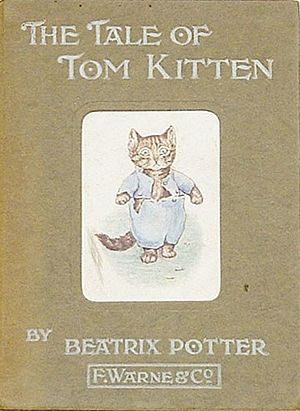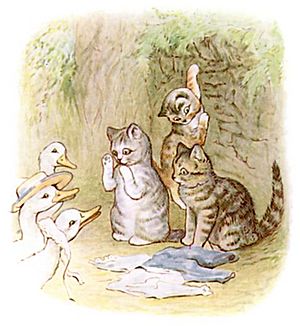The Tale of Tom Kitten facts for kids

First edition cover
|
|
| Author | Beatrix Potter |
|---|---|
| Illustrator | Beatrix Potter |
| Country | England |
| Language | English |
| Genre | Children's literature |
| Publisher | Frederick Warne & Co. |
|
Publication date
|
September 1907 |
| Media type | Print (hardcover) |
| Preceded by | The Story of Miss Moppet |
| Followed by | The Tale of Jemima Puddle-Duck |
The Tale of Tom Kitten is a fun children's book written and illustrated by Beatrix Potter. It was first published in September 1907. The story teaches us about good manners and how children sometimes react to rules. It's about a cat named Tabitha Twitchit who invites friends over for tea. She tries to get her three kittens ready for the party, but they quickly get their clothes dirty and lost while playing in the garden. Tabitha is not happy! She sends the kittens to bed and tells her friends they have the measles. But even from upstairs, the kittens cause a lot of noise, messing up their bedroom.
Beatrix Potter became a famous children's author in 1902 with her book The Tale of Peter Rabbit. She kept writing and illustrating, and in 1905, she bought a farm called Hill Top in Lancashire (now Cumbria). She used money from her books to buy it. Many of her later stories, including The Tale of Tom Kitten, were inspired by this farm, its woods, and the nearby villages. Work on Tom Kitten started in 1906. The pictures in the book show the inside of the Hill Top farmhouse, its gardens, paths, and front gate.
Twenty thousand copies of the book were printed in September 1907, and more were printed later that year. Beatrix Potter even wrote tiny letters to child fans, pretending they were from the characters in the story. Over the years, Tom Kitten and other characters from the book have appeared on many items like porcelain figures and soft toys. The story is still very popular today and has been translated into many different languages.
Contents
What Happens in the Story?
The story begins with three cat siblings: Tom Kitten and his sisters, Moppet and Mittens. They are playing outside, rolling around in the dust. Their mother, Mrs. Tabitha Twitchit, is expecting important guests for tea. So, she brings the kittens inside to wash and dress them before her friends arrive. Tom is "very naughty" and scratches his mother while she tries to clean him.
Tabitha dresses Moppet and Mittens in clean pinafores and fancy collars. She puts Tom in "all sorts of elegant uncomfortable clothes" from a chest of drawers. Tom is a bit chubby, and he pops several buttons on his clothes. But his mother quickly sews them back on.
Mrs. Tabitha sends her kittens into the garden to keep them out of the way while she makes hot buttered toast for the party. She tells them to keep their clothes clean and to stay away from the pigsty, the dirty ash pit, Sally Henny Penny, and the Puddle-Ducks. Then, she goes back to her work inside.
Moppet and Mittens soon get grass stains on their pinafores. They climb onto the garden wall and lose some of their clothes as they go up. Tom has a harder time getting to the top of the wall. He breaks ferns and loses buttons everywhere. He looks very messy when he finally reaches the top of the wall and even loses his hat. His sisters try to help him, but the rest of his buttons pop off.
Three Puddle-ducks come walking along the road, making a "pit pat paddle pat! pit pat waddle pat!" sound. Jemima Puddle-duck and Rebeccah find some of the kittens' dropped clothes and put them on. The kittens lose the rest of their clothes as they climb down the wall. Moppet asks Mr. Drake Puddle-duck to help dress Tom. But instead, he picks up Tom's clothes and puts them on himself!
The three ducks then waddle off up the road. Just then, Tabitha comes out and sees her three children with no clothes on! She pulls them off the wall, gives them a little "smack," and takes them back to the house. "My friends will arrive in a minute, and you are not fit to be seen; I am affronted!" she says.
Tabitha sends her kittens upstairs to bed. She tells her guests that the kittens are in bed with the measles. However, the tea party is soon disturbed by "very extraordinary noises overhead." The playful kittens are romping around in their bedroom, making a huge mess. One picture shows the bedroom completely messy, with Tom wearing his mother's bonnet. The next picture shows Tabitha walking into the messy room. The author then tells us she will write a bigger book about Tom someday. In the end, the Puddle-ducks lose the kittens' clothes in a pond, and they have been looking for them ever since.
About Beatrix Potter
Helen Beatrix Potter was born on July 28, 1866, in London, England. She had a quiet childhood and was taught at home. She loved to read, paint, draw, and visit museums. She also kept many small animals as pets. Her love for nature and country life grew during holidays in Scotland and the Lake District.
As a young woman, Beatrix continued to paint and draw. She had her first success in 1890 when she sold six drawings of humanized animals to a greeting card company. She wanted to have a useful life and be independent from her parents.
Beatrix Potter stayed in touch with her last teacher, Annie Carter Moore, and became very fond of Mrs. Moore's children. In the 1890s, she wrote story and picture letters to them. Mrs. Moore saw how good these letters were and encouraged Beatrix to publish them. Beatrix liked the idea. In 1900, she changed a story she had written for five-year-old Noel Moore in 1893. She made it into a small book, like the popular book The Story of Little Black Sambo. She couldn't find a publisher at first, so she printed it herself in December 1901 for her family and friends.
A company called Frederick Warne & Co. had first said no to her story. But they changed their minds and decided to publish her "bunny book," which became The Tale of Peter Rabbit. It was released on October 2, 1902, and became very popular.
Beatrix Potter continued to publish books with Warnes. In July 1905, she bought Hill Top, a working farm in the Lake District, using the money from her successful books.
Other Books and Items with Tom Kitten
In October 1908, another book called The Tale of Samuel Whiskers or The Roly-Poly Pudding was published. This story also featured Tom Kitten, his mother, and his sisters.
A book called Tom Kitten's Painting Book came out in June 1917. It had a picture on the cover of Tom standing at an easel with a paintbrush. This was the second of Beatrix Potter's painting books for children. These books had a colored picture on one page and an outline of the same picture on the opposite page for children to color.
In December 1935, two music books for piano were published, inspired by Peter Rabbit. One of the songs in the first book was called "Tom Kitten."
Beatrix Potter believed her stories would become classics, and she was one of the first authors to create merchandise based on her characters. She made things like a Peter Rabbit doll and nursery wallpaper. After she passed away in 1943, other companies were allowed to make items based on her characters.
Beswick Pottery started making porcelain figures of Tom Kitten in 1948. They also made figures of Tabitha Twitchit, Mr. Drake Puddle-Duck, Rebeccah Puddle-Duck, and Mittens and Moppet. You could also find Tom Kitten mugs and plaques.
Small enamel boxes were made by Crummles, with pictures of Tom Kitten characters on their lids. A biscuit tin also featured Tabitha Twitchit sewing Tom Kitten's button.
Soft toy companies also started making plush toys of the characters. In 1973, a soft Tom Kitten dressed in his fancy clothes was one of the first characters released by The Eden Toy Company.
Schmid & Co. also made many items from 1977 to 1995. They created music boxes featuring Tom Kitten and other characters. They also made ceramic Christmas ornaments of Tom Kitten and the Puddle-ducks.
Books Around the World
As of 2010, all of Beatrix Potter's 23 small books are still being printed. You can buy them in sets or as one big book. Tom Kitten is even available as an e-book!
Beatrix Potter's books have been translated into almost thirty languages, including Greek and Russian. Tom Kitten was even released in braille in 1921 for people who are blind. This shows how popular her stories are all over the world.
Tom Kitten on Screen
- In 1971, the character of Mrs. Tabitha Twitchit appeared in the Royal Ballet film, The Tales of Beatrix Potter.
- In 1992, the story was made into an episode of the animated BBC TV series, The World of Peter Rabbit and Friends. This episode also included The Tale of Jemima Puddle-Duck.
- Jemima Puddle-Duck and one of Tom Kitten's sisters, Mittens, appear in the 2012 computer-animated TV series Peter Rabbit on Nickelodeon.
- The character of Tom Kitten is also in the film Peter Rabbit 2: The Runaway, with his voice done by Damon Herriman.


